Dairy Groups Send Letter to President-Elect Trump Seeking Dialogue on Dairy Trade
December 06, 2016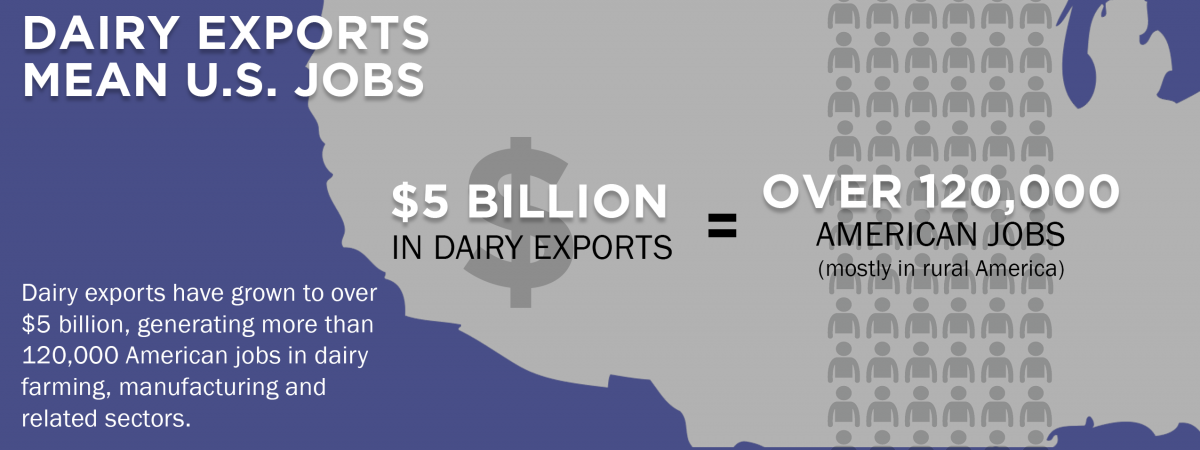
With President-elect Trump and a new Congress about to take office next month, NMPF is seeking a dialogue with incoming officials on several issues critical to the health of America’s dairy farms. This list includes leading a discussion about how U.S. dairy exports help the economy and benefit from an effective trade policy, as the National Milk Producers Federation and the U.S. Dairy Export Council (USDEC) explained in a letter sent Tuesday to President-elect Donald Trump.
In the groups’ letter to the President-elect, NMPF President and CEO Jim Mulhern, and USDEC President Tom Suber, highlighted the positive impact that prior trade agreements’ agricultural provisions have had on the dairy industry and, further, on employment in rural America. To maintain these benefits, the letter said, it is important to preserve current overseas dairy sales while seeking to achieve new gains by removing foreign barriers that currently hold back additional exports.
The USDA estimates that at the dairy farm level, each $1 billion of U.S. dairy exports generates more than 20,000 jobs and almost $3 billion of economic output. At the manufacturing level, USDA calculates that U.S. dairy exports support approximately 3,200 jobs per $1 billion of exports. Currently, the U.S. exports the milk produced on American farms one day of each week.
“During the last two decades, dairy exports have grown from less than a billion dollars a year to over $5 billion last year, in the process generating more than 120,000 jobs in dairy farming, manufacturing and related sectors,” the letter said. A 2015 NMPF economic analysis calculated that U.S. free trade agreements’ (FTAs) dairy provisions have played a key role in that growth, generating an additional $8.3 billion for the industry between 2004-2014.
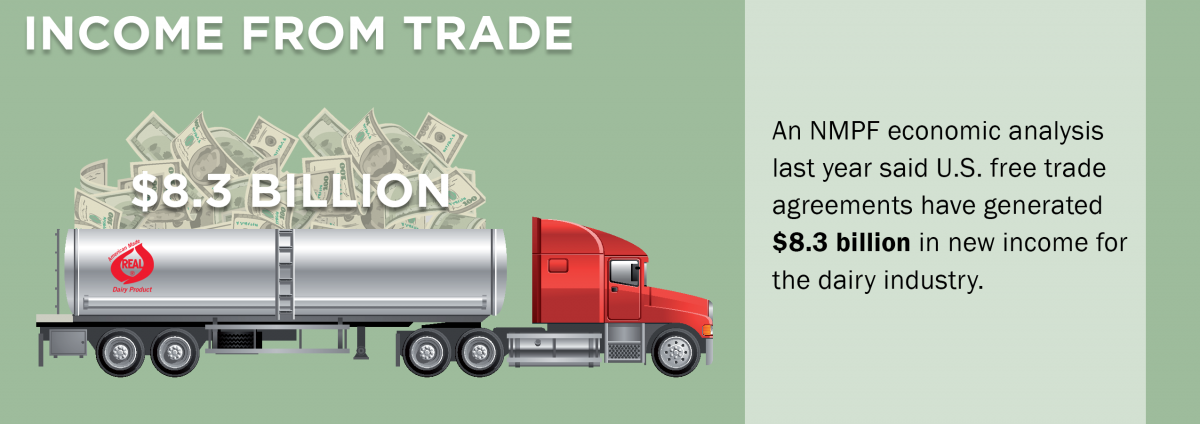 To maintain and grow those sales, U.S. dairy farmers and processors need a level international playing field to compete, the letter to Trump noted. Additionally, NMPF and USDEC noted their agreement with President-elect Trump that current trade agreements must be strictly enforced. Protectionist policies that run contrary to established agreements, such as the Canadian dairy pricing schemes and the European abuse of geographical indications, must be immediately addressed and reversed. NMPF and USDEC also listed other key factors to help preserve overseas dairy sales, including a focus on how U.S. regulatory agencies should do more to resolve technical trade barriers to exports.
To maintain and grow those sales, U.S. dairy farmers and processors need a level international playing field to compete, the letter to Trump noted. Additionally, NMPF and USDEC noted their agreement with President-elect Trump that current trade agreements must be strictly enforced. Protectionist policies that run contrary to established agreements, such as the Canadian dairy pricing schemes and the European abuse of geographical indications, must be immediately addressed and reversed. NMPF and USDEC also listed other key factors to help preserve overseas dairy sales, including a focus on how U.S. regulatory agencies should do more to resolve technical trade barriers to exports.
“We want to work with you to grow the rural economy and increase American jobs for dairy farmers and processors,” the letter concluded, “by tackling the various international trade challenges facing them.”
MPP Forecast: December
December 06, 2016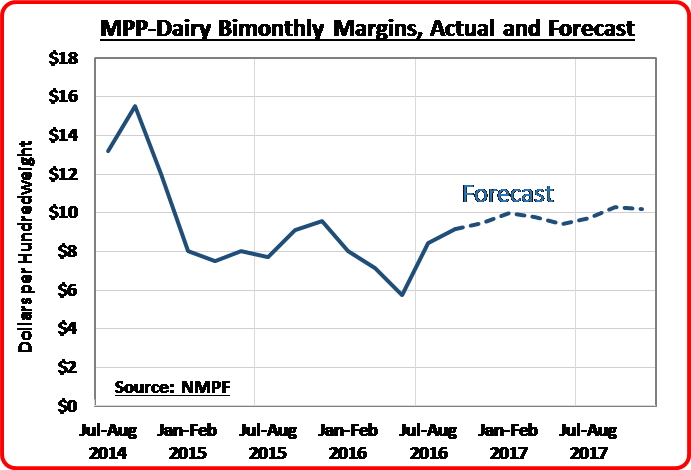
USDA’s National Agricultural Statistics Service (NASS) last week reported the October U.S. average all-milk price at $16.60 per hundredweight., down 70 cents from September’s price. The drop in October was closely related to changes in federal order class prices from September to October, when the Class III price fell by $1.57 per hundredweight, the Class IV price was down by $0.59 per hundredweight., and the Class I mover nudged ahead just 4 cents.
USDA’s Agricultural Marketing Service (AMS) last week also announced the November class and component prices. From October to November, the Class III price rebounded by $1.94 per hundredweight, the Class I mover dropped by $1.82 per hundredweight (mirroring the drop a month earlier in the Class III price), and the Class IV moved ahead by 10 cents. The combined result of these announced price changes is likely to be that the November all-milk price will bounce back to its September level ($17.30 per hundredweight) when it is announced at the end of this month.
USDA-NASS last week also reported feed prices for October. The NASS price announcements will result in a September-October MPP margin of $9.165 per hundredweight. USDA’s current forecast (at right), based on the December 1 CME futures settlements, projects that the MPP margin will remain above $10.00 per hundredweight through 2017. USDA’s MPP margin forecasts are updated daily online.
Dairy farmers have from now until Dec. 16 to enroll in the Margin Protection Program for coverage in 2017, or to change their coverage level if they are already participating in MPP. NMPF’s Future for Dairy website offers a variety of educational resources to help farmers select the desired coverage level.
NMPF Urges Participation in Upcoming USDA Dairy Cost of Production Survey
December 06, 2016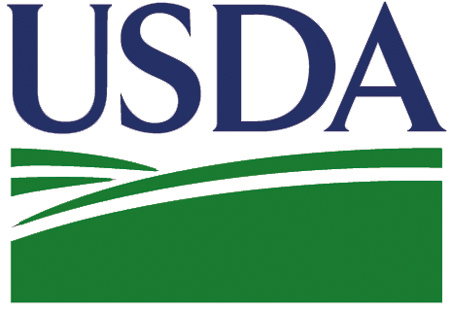 The U.S. Department of Agriculture’s National Agricultural Statistics Service (NASS) is in the process of conducting its Agricultural Resource Management Survey (ARMS) for dairy farms, also known as the Dairy Cost of Production Survey. NMPF makes extensive use of this information and strongly encourages dairy producers to participate if called upon to do so. Specifically, NMPF will be using USDA cost of production data as it works with the new Congress to make improvements in the Margin Protection Program.
The U.S. Department of Agriculture’s National Agricultural Statistics Service (NASS) is in the process of conducting its Agricultural Resource Management Survey (ARMS) for dairy farms, also known as the Dairy Cost of Production Survey. NMPF makes extensive use of this information and strongly encourages dairy producers to participate if called upon to do so. Specifically, NMPF will be using USDA cost of production data as it works with the new Congress to make improvements in the Margin Protection Program.
The ARMS survey provides updated information about the financial well-being, costs of production and production practices of the U.S. dairy sector. In addition to providing solid data for USDA research on dairy production, the ARMS survey information is used to build accurate baseline information for the USDA monthly and annual reports on the cost of milk production. The ARMS surveys examine selected commodities on a rotating basis. This year, it is collecting data for corn and milk production, including the organic dairy sector. Dairy production is surveyed every five years.
Last summer, USDA screened and selected a sample of 3,269 dairy producers in 28 states for the survey. The survey will be administered by trained field enumerators who will schedule appointments from December 2016 through April 2017 with the individual dairy operators in the sample. The higher the participation in this year’s dairy ARMS survey, the better the quality of the information available to the industry. If you have any questions about participating, please contact Peter Vitaliano.
CWT-Assisted Export Sales Contracts Total 4.5 Million Pounds in November
December 06, 2016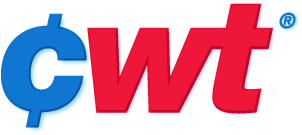 Cooperatives Working Together assisted member cooperatives in securing 22 contracts to export 3.1 million pounds of American-type cheese and 1.4 million pounds of butter in the month of November. The products will go to customers in Asia, the Middle East, North Africa and Oceania. The product will be shipped from November 2016 through February 2017.
Cooperatives Working Together assisted member cooperatives in securing 22 contracts to export 3.1 million pounds of American-type cheese and 1.4 million pounds of butter in the month of November. The products will go to customers in Asia, the Middle East, North Africa and Oceania. The product will be shipped from November 2016 through February 2017.
Year to date, CWT has assisted its members in winning export sales contracts totaling 47.3 million pounds of American-type cheese, 12.7 million pounds of butter (82% milkfat) and 21.3 million pounds of whole milk powder, destined for customers in 24 countries on five continents. These sales are the equivalent of 878.5 million pounds of milk on a milkfat basis. Totals are adjusted for cancellations received during the month.
Assisting CWT member cooperatives gain and maintain world market share through the Export Assistance program in the long-term expands the demand for U.S. dairy products and the U.S. farm milk that produces them. This increases demand which positively affects all U.S. dairy farmers by strengthening and maintaining the value of dairy products that directly impact their milk price.
The amounts of dairy products and related milk volumes reflect current contracts for delivery, not completed export volumes. CWT will pay export assistance to the bidders only when export and delivery of the product is verified by the submission of the required documentation.
All cooperatives and dairy farmers are encouraged to add their support to this important program. Membership forms are available online.
FARM Program’s Year in Review
December 06, 2016Even before it ends, 2016 has been a busy year for the National Dairy FARM Program, complete with the addition of new team members, plenty of training events and the rollout of new materials in preparation for the introduction next month of FARM Animal Care Version 3.0.
One important milestone was achieved this year: The FARM Animal Care Program now has 98 percent of the U.S. milk supply enrolled, thanks to the value the program provides by assuring customers and consumers that their dairy products come from farms that take the utmost care of their animals. The FARM Program greatly appreciates the support for the program by all of its participating co-ops, processors and most critically, farmers.
Here are some other changes the FARM Program underwent this year:
Team Additions
In May, FARM welcomed two new team members to manage its day-to-day activities. Emily Yeiser Stepp joined as the new director of the FARM Animal Care Program, and Beverly Hampton joined as program coordinator, focusing on communication and outreach. Ryan Bennett, NMPF’s Senior Director of Sustainability and Industry Affairs, now manages FARM Environmental Stewardship, a voluntary program set to launch in 2017, and Jamie Jonker continues to direct FARM Antibiotic Stewardship. Emily Meredith continues to oversee the entire FARM team, now as NMPF Chief of Staff.
Animal Care Version 3.0 Finalized
The latest version of FARM’s Animal Care program will be implemented starting Jan. 1, 2017. In addition to the Version 3.0 FARM Animal Care Manual, FARM is offering other complimentary materials to assist participating co-ops, processors and farmers in preparing for the new version. Additionally, customizable binders are available that cooperatives and processors can order for their members that will provide these materials in hard copy.
Also in preparation for FARM Animal Care Version 3.0, FARM staff hosted four regional Train-the-Trainer events. More than 100 trainers came to Ithaca, N.Y., Minneapolis, Minn., Columbus, Ohio, and Phoenix, Ariz., to participate in two days of intensive training provided by experts from Praedium in conjunction with the FARM Animal Care staff.
Materials and other information on FARM 3.0 are available on the FARM Program website. Additional materials related to animal care will be available in 2017.
FARM Stakeholder Engagement
For the first time, the FARM Program hosted a full day of programming at the annual meeting of the American Association of Bovine Practitioners (AABP) to further engage with the veterinary community.
Veterinarians have and will continue to play an integral role in ensuring excellent animal care on dairy farms. With a heightened focus on a Veterinarian-Client-Patient-Relationship and the Herd Health Plan in Version 3.0 of FARM Animal Care, the AABP meeting was an excellent venue to communicate the importance of veterinary involvement.
Additionally, FARM held its first-ever Evaluator Conference last month in Nashville, TN as a professional development and networking opportunity for nearly 70 FARM Program evaluators. Attendees participated in leadership development training, learned how to further help farmers embrace the FARM program, and heard about the latest research related to animal welfare and sustainability. Bringing together evaluators from all over the country allowed for shared conversations around successes, challenges and peer-to-peer learnings.
2016 NMPF Dairy Data Highlights Now Available
December 06, 2016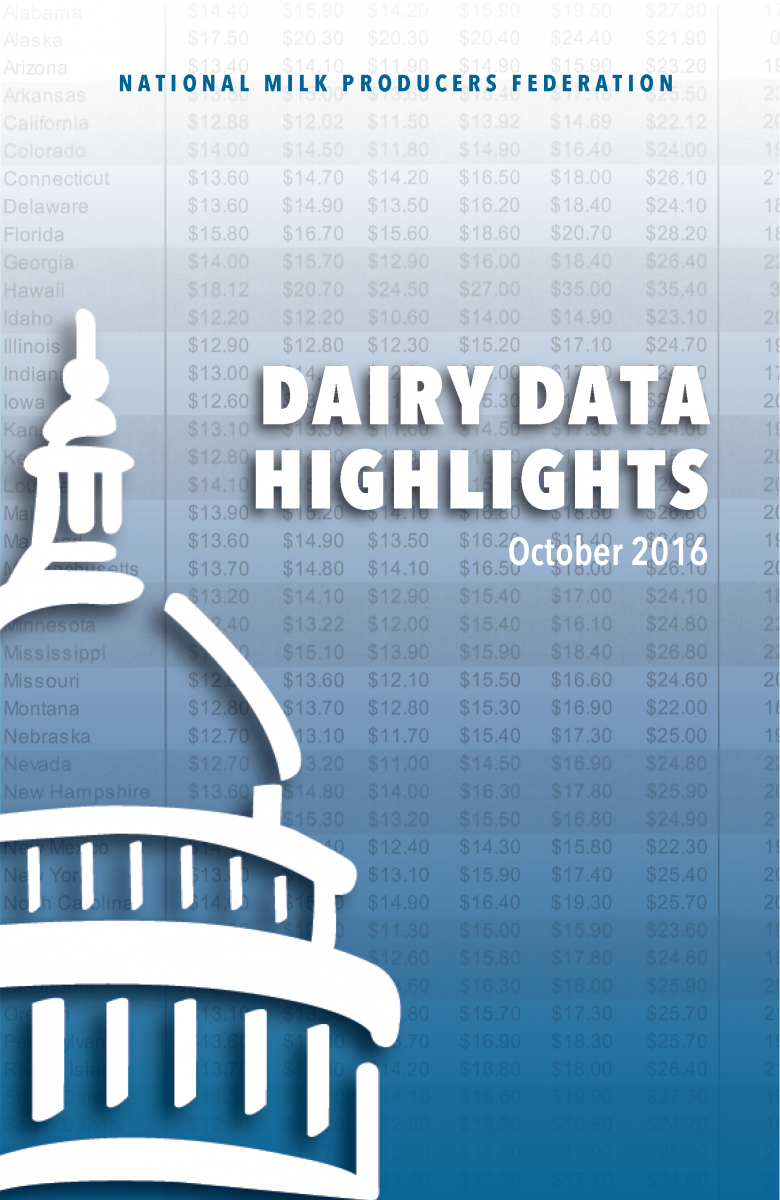 The 2016 edition of NMPF’s Dairy Data Highlights – complete with a redesigned cover – is now available to order.
The 2016 edition of NMPF’s Dairy Data Highlights – complete with a redesigned cover – is now available to order.
The Dairy Data Highlights booklet is an extensive collection of tables and graphs that provides national and state data on all aspects of milk production, federal milk marketing orders, sales of milk and dairy products, farm and retail prices, and dairy product production, as well as dairy export and import information through 2015. It has been published annually by NMPF for more than 60 years.
Copies of the current Dairy Data Highlights are available at the following rates:
NMPF member cooperatives or associate members:
Fewer than 10 copies: $7.50/booklet
Orders larger than 10: $5.00/booklet.
Non-members:
Fewer than 10 copies: $10/booklet
Orders larger than 10: $7.50/booklet.
To purchase copies, complete an order form and mail it back to NMPF with payment. We accept checks or money orders. Checks should be made payable to the National Milk Producers Federation. Booklets will be mailed upon receipt of payment. The booklet is not available electronically.
NMPF Perspective on Antimicrobial Resistance Reflected at International Codex Meeting
December 07, 2016As governments around the world focus additional resources on battling the rise of antibiotic resistant bacteria and its causes, NMPF continues to engage on behalf of the U.S. dairy industry at international discussions of the emerging public health concern – including an international meeting last week.
The Codex Alimentarius Commission, created in 1963 to develop international food standards that protect consumer health and promote fair trade practices, is one of the key global platforms for addressing the intersection of food safety and antibiotic use. Back in July, the Codex Commission approved the re-establishment of an intergovernmental Task Force on Antimicrobial Resistance, a group that develops science-based guidance on the management of foodborne antimicrobial resistance.
Last week, a working group met in London to finalize the task force’s Terms of Reference and draft proposals for new work to revise guidelines to monitor for and reduce the incidence of antibiotic resistance bacteria. Dr. Jamie Jonker, NMPF Vice President for Sustainability & Scientific Affairs, is representing U.S. dairy interests as a Codex stakeholder through his involvement with both the U.S. government delegation to Codex, and his engagement with the International Dairy Federation. His work is also made possible through support of the U.S. Dairy Export Council.
In comments submitted to the U.S. Codex delegates on Oct. 6, NMPF asked for more clarity in the Terms of Reference, and proposed new work items to ensure that the task force focuses on managing antimicrobial resistance through the food chain. In London last week, the Codex working group adopted key elements of NMPF’s request to focus this effort on food safety and fair trade in food. The revised project documents will now be submitted to the 40th Session of the Codex Alimentarius Commission for adoption. The resulting standards are intended to give countries guidance on how to manage antimicrobial resistance through the food chain.
New Documents Outline Expanded Drug Residue Testing Program
December 07, 2016As state and federal milk safety regulators begin developing a new program to test for tetracycline residues in raw milk samples, details about this new Appendix N program are beginning to emerge through the National Conference of Interstate Milk Shipments (NCIMS) website. NMPF has been engaged in the NCIMS process since the organization voted at its 2015 meeting to expand the required testing of milk for drug residues beyond beta-lactams.
While the new pilot program will target the tetracycline class of drugs (which indulges oxytetracycline, tetracycline and chlortetracycline), the timing of when that testing will commence has yet to be determined. Once the implementation date is announced – likely not until the spring of 2017 – NMPF will host a webinar for its members outlining the nature of the sampling process.
To prepare the industry for the next step, the NCIMS has released the following draft documents:
- DRAFT 2015 NCIMS Proposal 211 Pilot Program Accepted Tetracycline Test Kit Using Both Undiluted and Diluted Steps
- DRAFT Appendix N Pilot Program Question and Answer Version 3
- DRAFT PowerPoint 2015 NCIMS Proposal 211 Raw Milk Testing Pilot for Non-Beta Lactam Drugs Version 3
- DRAFT Appendix N Modification LEO Responsibilities for New Tetracycline Test Kits
NMPF staff will continue to work with the Appendix N Committee on the remaining details of the pilot program. As NMPF members review these documents, please contact Beth Briczinski with questions or feedback
Effort to Update School Milk Program Fades at End of 2016
December 07, 2016Efforts to update child nutrition programs – and to enhance the milk options available in school lunch programs – faded this month as negotiations between the Senate and House failed to arrive at new school nutrition legislation.
The authorization for federal child nutrition programs formally expired at the end of September 2015, but existing programs continue to operate pending approval of a bill to reauthorize federal feeding programs, including school lunch regulations. NMPF worked on a bipartisan basis with both the House and Senate during the past two years to include language in the reauthorization bill that would prompt the U.S. Department of Agriculture (USDA) to review milk consumption in school meals and WIC programs, as well as take steps to increase the intake of milk and the nutrients it provides.
NMPF held out hope that the December congressional lame-duck session would offer the opportunity to pass the nutrition legislation, but Senate Agriculture Committee Chairman Pat Roberts (R-KS) said this week that negotiations have reached an impasse.
"I'm very disappointed that the bipartisan, bicameral Child Nutrition Reauthorization negotiations have come to an end for the 114th Congress,” Roberts said. “I remain committed to continuing to look for ways to increase integrity within the program and to provide flexibility to local school and summer meal program operators.”
Both the Senate and House Agriculture Committees had approved legislation in the past year, supported by NMPF, to reverse the decline of milk consumption in schools. NMPF’s goal was to prompt a reassessment of the current USDA policy that only allows fat-free flavored milk – and not 1% flavored milk – in the school lunch line, even though federal dietary guidelines support the inclusion of low-fat flavored milk.
After USDA removed low-fat flavored milk from lunch programs, schools served 187 million fewer half-pints of milk during the years 2012-2014, although total public school enrollment grew during that period.
“We will continue to work on this issue in the coming year to bolster the important role of milk in the nation’s schools,” said NMPF President and CEO Jim Mulhern. “Ignoring the decline in school milk consumption could have serious consequences for children’s health today and throughout their adult lives.”






